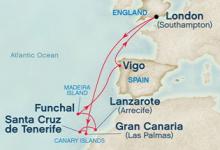Recently Viewed Cruises
- Catch up on Cruising: Latest cruise news in bite size
- Royal Caribbean International raises the bar
- Classy Astor fills gap in market
- Oceanic Discoverer
- Ab Fab Oosterdam
- Frequently Asked Questions
-
Crown, Canary Islands ex Southampton Return
Nights 11 Ship Crown Princess Star Rating 
Departs Southampton, England Sailing 2013: 30 Apr ,1 Jun Ports of Call Southampton, Gran Canaria (Las Palmas), Santa Cruz de Tenerife, Arrecife, Funchal (Madeira), Vigo Please enquire about this cruise for pricing.
11 Night Cruise sailing from Southampton roundtrip aboard Crown Princess.
Crown Princess is the crown jewel of the Princess fleet. Its unique Crown Plaza is an atrium designed in the spirit of an Italian piazza where you can get a bite to eat or just relax and people-watch. Other highlights of this brand new ship include the Crown Grill, modeled after a classic steakhouse, the Sanctuary deck area, reserved just for adults, and Movies Under the Stars®, our poolside movie theater.
Highlights of this cruise:
Southampton
The south of England boasts a dramatic coastline that encloses some of the most beautiful countryside in Britain. The landscape of hills and heaths, downs and forests, valleys and dales, is without rival. Southampton serves as your gateway to the countryside - and to a wide variety of historic sites, national landmarks and charming. And of course, London is a two-hour drive by modern highway.
The United Kingdom's premier passenger ship port, Southampton was home for many years to the great transatlantic liners of yesteryear.
Gran Canaria
The Canary archipelago was sculpted by a period of intense volcanic activity; its islands possess a stark, near lunar beauty. Gran Canaria is the third-largest island in the group and is often described as the 'Round Island' for its near-circular shape. Las Palmas, its capital, is also the largest city in the Canaries numbering some 500,000 souls. Despite the seemingly inhospitable landscape, farmers in Gran Canaria's Angostura Valley cultivate abundant crops of tomatoes, onions, melons, and figs. Moreover the island's climates, lack of rainfall, and fine beaches have long drawn Europeans seeking the winter sun.
Santa Cruz
Tenerife is the largest island in the Canary Archipelago. Like its brethren, Tenerife was formed by fierce volcanic activity. Its landscape remains dotted with volcanic cones and areas of intense geothermal activity. Towering over the island is Mt Teide, an extinct volcano that, at 12,200 feet above sea level, is the highest peak in Spanish territory. Santa Cruz de Tenerife is the island's capital and your port of call.
Tenerife's north shore is separated from the south by rugged mountains, creating a rain shadow. The majority of the islands most recent resorts are found in the sere and parched south shore.
Lanzarote
Lanzarote is the fourth-largest island in the Canary chain. The most easterly of the Canaries, the island lies some 70 miles off the shore of North Africa. Like its neighbours, Lanzarote was shaped by a period of intense volcanic activity. The resulting landscape possesses a stark, near-lunar beauty: Over 300 now-dormant volcanoes left behind petrified lava seas and deep layers of volcanic ash. Today, visitors to these "Mountains of Fire" ride camels through the lava beds and even enjoy a volcano-broiled steak at the park's restaurant. (Subsurface temperatures still reach 800F in the park.) Despite the seemingly barren land scape, island farmers grow abundant crops of tomatoes, onions, melons, and figs in addition to Malvasia, a clear yellow wine produced from malmsey grapes. Lanzarote's rugged landscape, its warm climate, its lack of rainfall, and its beaches have proved attracted to travellers: Tourism dominates the island economy with some 2 million visitors arriving annually.
Vigo
Vigo clings to the slope of Monte del Castro, overlooking a namesake bay so vast, it could shelter an entire fleet. The city's medieval heritage is seen in the narrow streets and granite houses of the Ribera del Berbes, the old fishermen's quarter. Vigo is also the gateway to Santiago de Compostela, the most venerated shrine in all Europe during the Middle Ages. Pilgrims from the four corners of Christendom flocked to the magnificent cathedral, built between the 12th and 13th centuries. The cathedral still draws thousands of daily visitors today.
An important fishing and commercial port, Vigo was first settled by Celts 600 BC. The Celtic legacy lingers on in the province's old legends - and in the bagpipes played on festive occasions.







